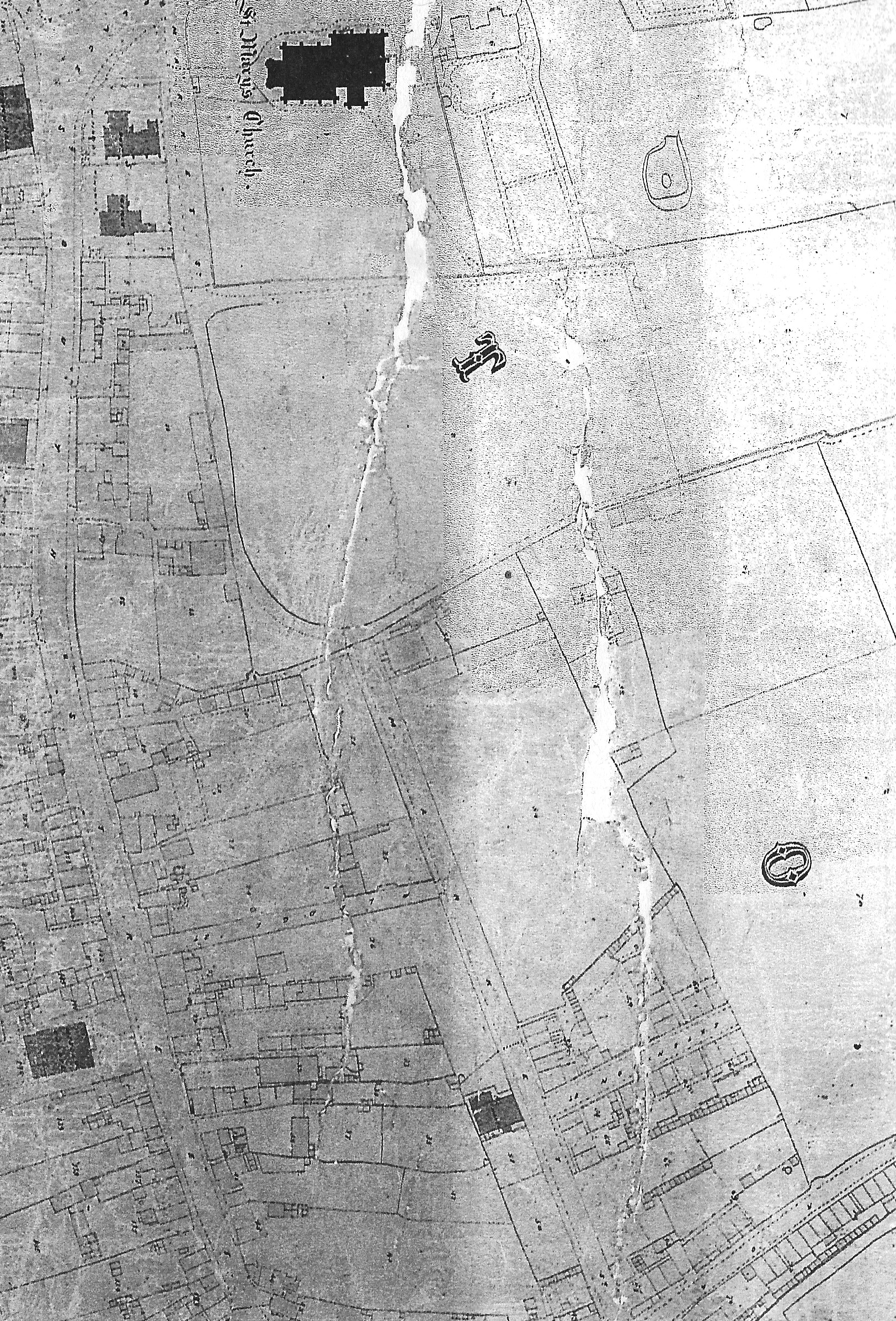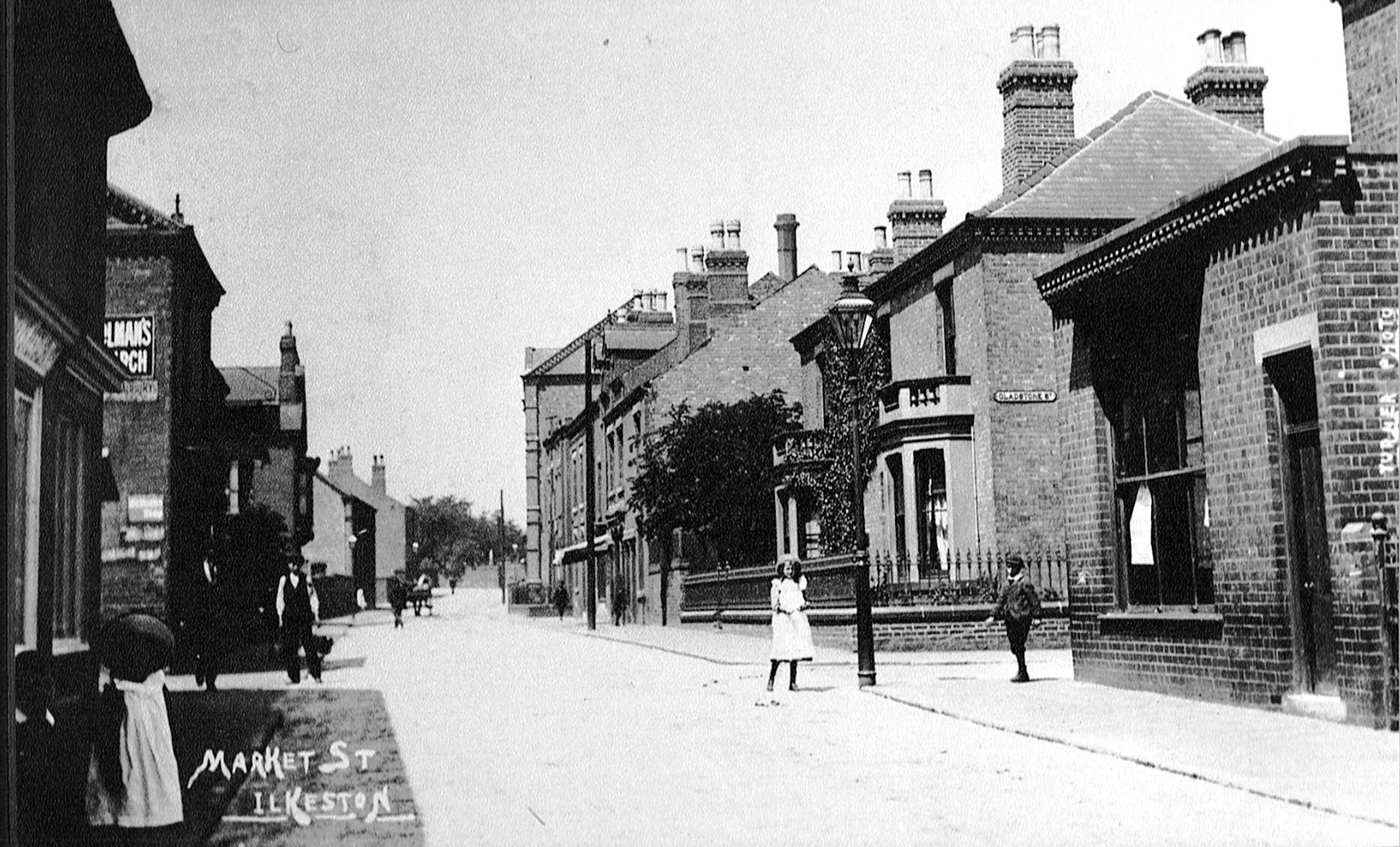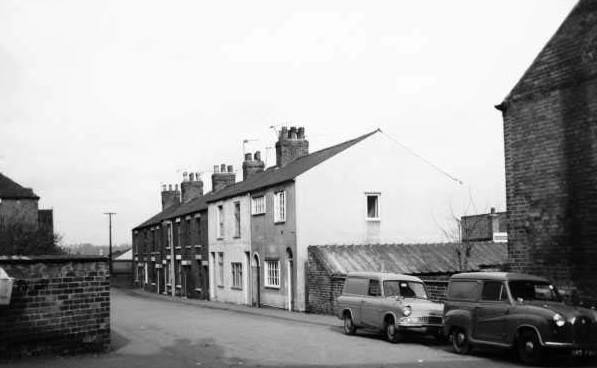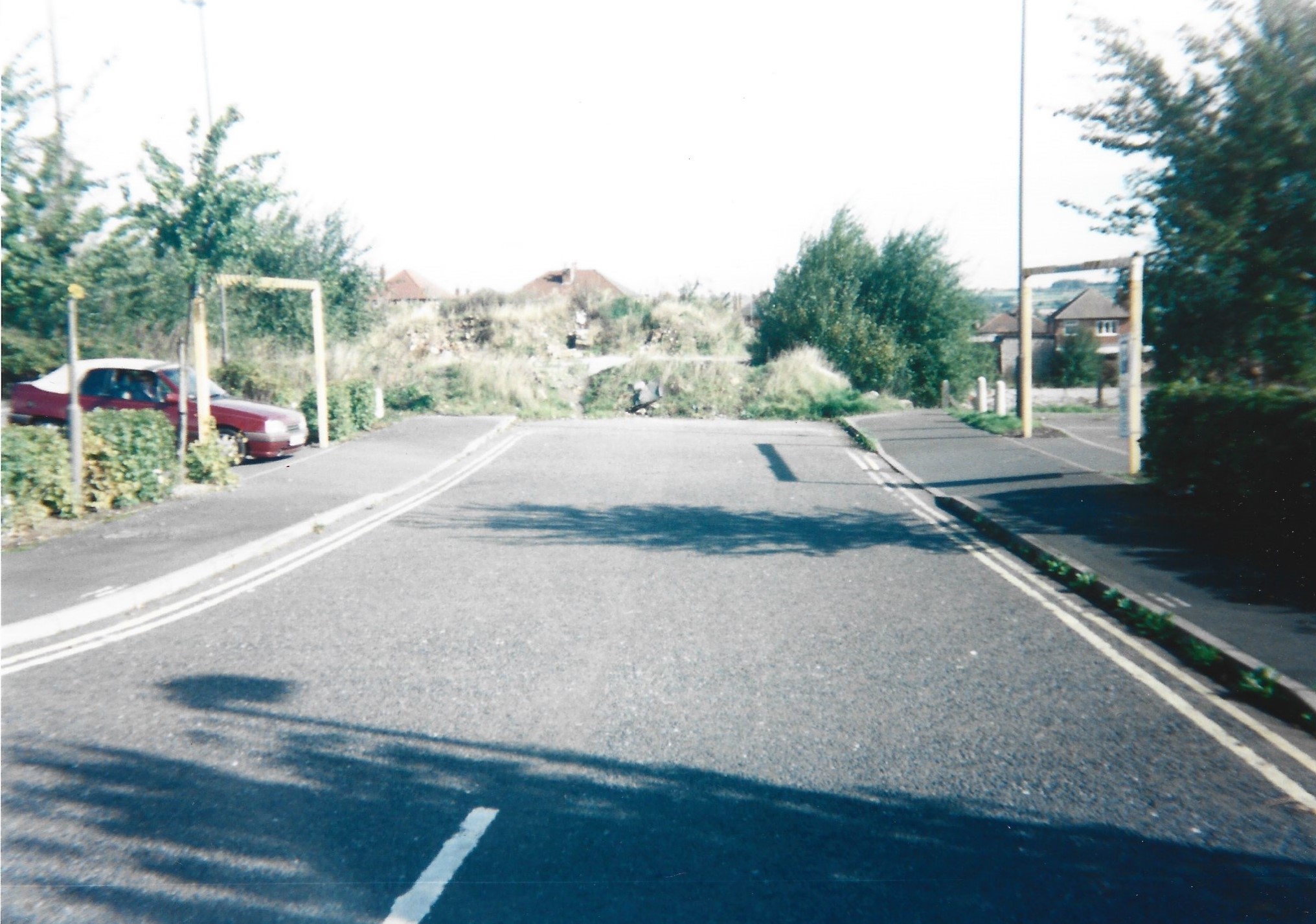Market Street
And so we come to Market Street, linking the White Lion area to the Market Place, running parallel to South Street on its east side. The Ilkeston Pioneer reported on the beginnings of an idea for this new street in March 1853 …
‘We are glad to learn that it is in contemplation to form a new street commencing at the south side of the Market-place, running along the Cricket Ground, and the fields adjacent, until it joins the Nottingham Road, of which important thoroughfare, it will form a continuation. This, should the project be carried out, will be a decided improvement, and a great public convenience, to say nothing of its enhancing the value of land along the line of the street’.
Such a new street would mean that the toll bar, set at the south end of South Street, would be redundant unless it moved elsewhere … passenger and goods traffic would simply be able to avoid it by travelling along the new route.
[At the same time there were discussions between certain local landowners — including William Ball — and the directors of the Midland Railway, to construct another new thoroughfare, from the junction of Chapel Street (which was then a dead end) and Burr Lane, northwards to Awsworth Road/Cotmanhay Road and crossing the railway line near the Town Station (along the line of what was later North Street/North Road).]
Above is part of the Local Board Map of 1866, showing Market Street and, just off the bottom of the map is where it joins with Park Road. Adeline wrote about this area, stating that “the old Wesleyans, after leaving South Street Chapel, worshipped in a small chapel on the west side of Market Street, below Gladstone Street. On the east side was Extension Street. In this new street were Mr. John Childs’ houses built about 1857 which have been dubbed ‘ Little Peck* Row.’ Mr. Childs had sold large quantities of potatoes, and unkind people said that he had been able to build these houses because he gave short weight.”
*A ‘peck’ is an imperial unit of capacity equal to two gallons or just over nine litres — as in ‘Peter Piper picked a peck of pickled peppers’. It was a bulk food measure and so the suggestion is that John Childs wasn’t too careful when measuring out his produce.
Having earlier given his views on Park Road, here is Aesculapius again, in 1871:
“Look at Market-street and Gladstone-street, which years ago were set out by Mr. Hobson, and which have ever been and remain in a most abominable condition – a disgrace even to the names of Hobson and Gladstone, and the Ilkeston Local Board”.
You are looking up Market Street towards the Market Place. You can see Gladstone Street on your left and on your right, traversing Market Street. Extension Street leads off from the east side (right) of Market Street, and is behind the photographer’s right shoulder. Bright Terrace leads off Extension Street. The latter two streets have disappeared because of the town’s bypass road.
———————————————————————————————————————————————————
Extension Street and Bright Terrace
Previously part of a close called the South end of the Hayes, Extension Street — and off it, Bright Terrace — was home to about 19 households when fully occupied.
The name appears in records as early as 1855 and is listed on the 1861 census. It then appears on the next census, with Bright Terrace separately listed.
The Carrier brothers of William, Henry, Samuel and Joseph, and their nephew Henry MacDonald also held land and houses here. Before his death in 1858 William had built six houses here … at his death, they were occupied by the Martin, Crookc, Bryan, Blake and Benison families. (see below)
The street was declared a highway by the Local Board in 1876… in other words it had been ‘sewered, levelled, paved, flagged, metalled, channelled and made good’ to the Board’s satisfaction, and as articled in the Local Government Act of 1858. The southern part of Market Street was awarded the same status at the same time.
Under the terms of the Public Health Act of 1848 Local Boards could instruct property owners to improve any private street in which their property lay; if they refused then the Board would undertake the improvements and recover the costs from the owners. The Local Government Act of 1858 expanded these powers but gave owners certain appeal rights.
———————————————————————————————————————————————————
Adeline identifies that … “here lived Crooks, Martins, Harrisons, etc.”
In Extension Street, the early residents of the Carrier houses included the households of (and recalled by Adeline)…
Francis Thompson Crooks, lacemaker son of John and Sarah (nee Taylor), and whose paternal grandparents were cordwainer Thomas Crooks and Elizabeth (nee Thompson).
Living with Francis were his wife Mary (nee Flint) and their children.
Born in that street in 1861 was Edwin Bednall Crooks, illegitimate son of their daughter Rachel who six years later married Alfred Bednall.
The Bednalls were also residents of Extension Street for part of the 1860’s.
The Crooks are later listed in Bright Terrace.
Francis died in Extension Street in August 1878, aged 63.
The Martin family which came to Ilkeston from Shropshire in the later 1850’s.
This was iron miner Isaac, wife Sarah (nee Evans), and several children, of whom the first born in Ilkeston was Rebecca in 1857.
The family later moved into North Road while the 1881 census shows Sarah, now a widow, at Unstone, Derbyshire with several of her children. Her husband Isaac had died there in 1875.
Also there was eldest child Moses. He had married Elizabeth Flinders, daughter of Thomas and Ann (nee Trueman) of Flinders’ Row on Christmas Day of 1871, but she died in September 1879 and Moses quickly remarried, to Emma Hardwick.
The Harrisons ? (states Adeline) … yet another elusive Ilkeston Harrison! The only Harrison connection with the street which I have discovered is the birth of George Harrison there in 1883, the son of George and Rebecca (nee Winfield).
Other families not mentioned but living in the Carrier-built homes were those of….
Framework knitter William Benniston and his wife Eliza (nee Chambers).
Framework knitter John Blake and Hannah (nee Choulerton).
Lacemaker Joseph Bryan and Emma (nee Cockayne).
Tailor Norman Straw, born in 1824, a son of framework knitter Thomas and Eliza (nee Pares)
A Native of Ilkeston recalls Norman as “a nice little singer” in the Church Sunday School who was enlisted as a chorister by ‘Mr. Smedley’, the leader of a fine set of singers. “One fine Sunday morning, when the sun shone bright in the old church, Norman was put to sing in an anthem by himself. But a little robin had got in the church, and it sang out from the top of the pulpit, so that when Norman had done Mr. Robin continued the service”.
On October 15th, 1855 Norman married Catherine Brown, the illegitimate daughter of Ruth Brown and grand-daughter of the Burr Lane Browns, Thomas and Ann (nee Rawdin). There was a second illegitimate daughter, Ann, and some evidence that Catherine’s third child, son John, was also illegitimate.
On April 11th, 1830 Ruth Brown had married John Goddard, lacemaker son of Jonathan and Kitty (nee Daykin) and all the children took the surname Goddard. Like her mother, Catherine Brown alias Goddard had at least two illegitimate children — Henry Isaac born on April 5th, 1849 and Eliza Sarah born on April 5th, 1853, before she married Norman Straw.
Catherine’s illegitimate son, who always kept the Goddard name, doesn’t appear to have lived with his mother after her marriage but with other relatives and in the later part of his life he resided with his aunt Fanny Goddard who had married Thomas Lacey in 1869, at North Street and then in Byron Street. He died at 15 Byron Street in 1899, his age recorded as 52.
The illegitimate daughter Eliza Sarah did live with her mother and was a ‘Straw’ until she married blacksmith Thomas Inns in April 1876 when Norman was recorded as her father. It might be assumed that the father of Henry Isaac was not Norman Straw whereas he was the father of Eliza Sarah. However this remains my assumption without ‘proof’.
After marriage Norman and Catherine had at least nine more children and appear at Extension Street in the 1861 census, and throughout the following decade all their children were born there. The 1871 census shows them at Bright Terrace off Extension Street.
In 1877 their second daughter Hannah was confined in Mickleover Asylum as ‘an imbecile’, at a cost to the Basford Union of 11s per week. Norman was ordered to pay a weekly contribution of 2s 6d towards her keep, despite the fact that his wages were only 24s and he had four other children living with him.
Hannah died on February 28th, 1879, her gravestone stone showing her age as 24 – though she was just over 23.
Norman Straw was born in 1824 and has the ‘distinction’ of being the only person with that forename born in Ilkeston and appearing on an Ilkeston census — until joined by George Norman Barker, son of George and Mary (nee Malin), born in 1879.
———————————————————————————————————————————————————
Other, long-term residents of Extension Street at this time were ……
The Eaton family of Edmund, framework knitter son of William and Susannah (nee Shaw), his wife Ann (nee Winfield), daughter of George and Lucy (nee Harrison), and their children, one of whom was Lucy, born in 1849.
Lucy Eaton married coalminer William Walker in 1869 and the couple seemed to have a very tempestuous relationship.
Both had fierce tempers and in June 1878 Lucy summoned her husband for assault and using threatening language towards her.
The couple had been out together for most of the day and returned home about 11 o’clock in the evening, both somewhat inebriated. Their lodger asked Lucy to fetch him a pint of ale, giving her a shilling as payment. Husband William then asked her to bring some ale for him, pay for it out of the shilling and he would settle up with the lodger. Lucy returned with only one pint and that set William off!! Bad language was followed by a blow to the wife’s nose, more abusive language and another blow. Lucy tried to escape but the door was locked.
At Court William expressed humble contrition for his actions and Lucy was now reluctant to press charges. Consequently the case was adjourned for a fortnight, the couple agreeing to live more peaceably together.
That agreement quickly broke down however and the police were called on several occasions to find Lucy severely beaten.
In the Spring of 1879 an absent William was sentenced at the Petty Sessions to a month’s imprisonment with hard labour for assaulting Lucy in a drunken rage, and thereafter to find sureties to keep the peace for six months. The 1881 census lists William as an inmate of Vernon Street prison in Derby, serving another month’s imprisonment for assaulting Lucy.
In 1891 William was involved in another drunken fracas when he returned to the family home late one night determined to break his wife’s neck when he could find her. For a time Lucy thought correctly that hiding under the bed was the best option but she eventually emerged to be discovered by her husband whose beating of her was interrupted by a son. Pandemonium in the house followed and William ran outside in stocking feet, up the entry, into the arms of a policeman.
At Ilkeston Petty Sessions he was awarded another month in prison, with hard labour, for being drunk and disorderly. Lucy applied for and was granted a judicial separation, with custody of the children and two shillings a week as maintenance.
However by the end of the century she was again living with husband William and her illegitimate daughter Eliza Ann who was now the wife of tripe dresser William Henry Mellor.
The 1911 census finds Lucy and William still together at 22 Chapel Street, ‘celebrating’ 42 years of marriage.
When he married Caroline Bell, daughter of blacksmith and publican William and Phoebe (nee Riley) in June 1862, George Eaton, the eldest of the Eaton children, also set up home in Extension Street for a time — at number 1.
Elijah Eaton was Edmund’s nephew and the son of John and Mary Ann (nee Winfield), who was the sister of Edmund’s wife, Ann.
Elijah also established a home in the street after his marriage in March 1856 to Ann Burrows, daughter of Amos and Elizabeth (nee Garton) whom we shall meet shortly as we walk past Gladstone Street (See Gladstone Street).
Coalminer but later licensed hawker William Riley, with his wife Ann (nee Eaton), daughter of Henry and Betty (nee Henshaw), and children, who had settled in the street by 1861 and were to remain there for at least 20 years.
James Tunnicliffe, framework knitter, moved into the street in the early 1860’s with wife Emma (nee Hibbert), daughter of James and Sarah (nee Mart), and two children. Both James, aged 63, and Emma, aged 88, died at 11 Extension Street in 1902 and 1923 respectively.
James was christened at Ilkeston Wesleyan Methodist Chapel in 1837, son of James and Sarah (nee Bramley) when his date of birth was recorded as November 8th 1831.However most subsequent records including the census and his marriage entry in St. Mary’s parish register indicate a birth year of 1836/7. Could there be some confusion between birth and baptism?
Levi Clifford, furnace labourer, wife Eliza (nee Whitehead), daughter of Levi and Ann (nee Hooley) and children.
For a time Levi’s nephew Robert Clifford, ironstone miner and son of Joseph and Mary (nee Hardy), also lived in the street before moving into Park Road.
Extension street was also home to many Irish families in the later 1860’s and 1870’s.
In this area was Crooks’ Close and Crooks’ Row — which may have been another name for Bright Terrace?
Extension Street … taken from FaceBook (I lost the note of the photo’s origin. If anyone claims it I will gladly attribute it).
Extension Street 2000 … extending no longer (Bright Terrace led off at a right angle, at the far end, on the left).
In February 1898 the six Carrier houses in Bright Terrace were put up for sale by auction. They were then tenanted by needlemaker John Thomas Needham (number 1); Corporation labourer David Spencer (2); coal hewer Thomas Lynch (3); Thomas Bostock, deputy manager at a coal mine (4); the Dillings family (5); and coal hewer William Winfield (6). There was also a strip of building land in front of this row.
————————————————————————————————————————————————-
We now wander further along Market Street to the Anchor Inn and Hubert Henri Sugg.





